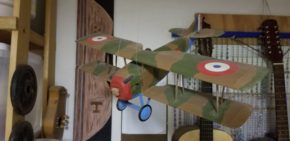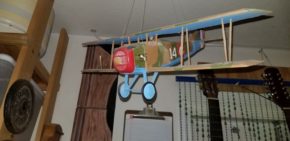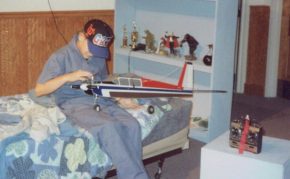In the mid-60’s, I was building plastic models but flying paper airplanes and the old “stick/wing/tail” rubber band planes. At some point, I remember building a simple balsa wood frame of a Cessna, covered it with tissue paper (using a smelly dope), and tried to fly it using rubber band power. I was somewhat successful in that the plane looked right, but I didn’t understand aerodynamics well enough to know how to make it fly correctly. Research back then was not as easy as it is today.
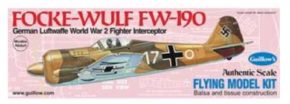
By the time I was in middle school, in the early 70’s, I tried more ambitious balsa wood planes, beginning with a Guillow’s Focke-Wulf 190. I found the construction very satisfying and, for some reason, painted the final plane a gloss black. It was also rubber powered, and would fly a little farther than previous models, but still not great. It was a good model nevertheless — definitely the largest model plane I ever owned. For some reason, my brother, Tom, and some of his friends grabbed that plane one evening when I wasn’t home and pelted it with darts. It was destroyed, but had become damaged from all my attempted flights anyway, so I wasn’t as upset as I probably should have been.
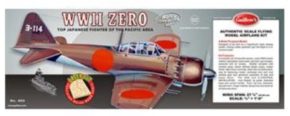
I soon decided to try it again. I have always appreciated the clean, graceful lines of the Mitsubishi Zero and found another Guillow’s kit — a Zero with a wingspan of almost 28″. It would be my largest model yet. Again, construction was time-consuming, but not difficult and I was extremely pleased with the results. I painted her the leaf green of the Japanese air force and named her Mitzi. The plane was a so-so rubber band flyer, but was easily damaged because of her large size and lightweight balsa construction. My efforts to improve her flight characteristics were not enough to achieve the smoothness that I thought it should and I spent about as much time repairing as I did flying. Eventually, she became damaged beyond repair and I ceremonially buried her in the backyard, her right wing emerging from the ground as her tombstone.
Later, in high school, I found a balsa and tissue model of a WWI Spad that seemed intriguing to me. This time I built her as a non-flying model. By doing this, her survival was assured. She turned out terrific and proudly hangs in my workshop to this day. She is a little worn, but merely from old-age (just like her builder!)
I graduated high school, then college, and finally moved to Florida. Model building took a back seat to “real life.” My creative outlet was the theatre and building the occasional dulcimer.
In the Spring of 1994, I produced my final mainstage show as the Drama Teacher at Crystal River Middle School. The show was called The Night of the Pterodactyl and the plot revolved around a kid who likes to fly radio controlled airplanes, eventually modifying one to look like a pterodactyl at the climax of the story. I wanted a working model plane — not to actually fly from the stage, but for the realism factor. Unfortunately, I did not know anyone from the world of R/C airplanes who might loan us one. So I paid a visit to Rob’s Hobby Shop near Ocala to inquire what to do, and wound up as the owner of a Hobbico Nexstar 40 ARF along with a transmitter. I built the plane to use in the show, but didn’t try to fly it until after the play was over. (By the way, notice the prop monster models, on loan from my collection, on the upstage bookshelf!)
I got information on how to join AMA (The Academy of Model Aeronautics) and located the local flying club who used a field off N. Maynard Road in Lecanto. It was a cow field — with cows. I was nervous about flying and had an expert pilot my plane first to check its flight characteristics, It flew fine, so I secured a co-pilot, Mr. Tom Marr, who attached a “buddy box” — another transmitter — to my radio if he needed to rescue me. I flew for several weeks, whenever Mr. Marr could be there, and slowly strengthened my confidence that I could do this on my own. After one successful flight, Tom suggested we fly again, so I fueled up and off we went. Unfortunately, I had neglected to check the charge on my battery and it went dead, plummeting the plane to earth where it augured into the ground in front of a cow. The plane was essentially in splinters. There was no more flying for awhile as I had no replacement plane. I did purchase another trainer — one that had to be constructed completely. I finished the frame of the wings and the fuselage, but then developed a wild hair — something I always wanted to try.
I decided I wanted to fly real airplanes instead of the models, so I plunked down some cash at the Crystal River airport in early 1995. I purchased the required textbooks and manuals for ground school and logged 4 hours in a Cessna 150 and 172 before my doctor discovered a lump in my chest. Life got a little sidetracked and I was grounded again. These are all stories for another time. Suffice it to say, I didn’t return to R/C flying…for 23 years.

